16. WORLD WAR – ROUND TWO

THE WAR IN ASIA AND THE PACIFIC OPENS UP
CONTENTS
 In early 1942 it appears as if Japan is In early 1942 it appears as if Japan is
unstoppable
 The Allies begin the assault on a The Allies begin the assault on a
retreating Japan
 The Doolittle raid on Japan - April 18, The Doolittle raid on Japan - April 18,
1942
 The Battle of the Coral Sea - May 4 - 8, The Battle of the Coral Sea - May 4 - 8,
1942
 The Battle of Midway - June 4 - 7, 1942 The Battle of Midway - June 4 - 7, 1942
 Guadalcanal (up from the South) Guadalcanal (up from the South)
 Burma and India Burma and India
The textual material on page below is drawn directly from my work
A Moral History of Western Society © 2024, Volume Two, pages 171-176
... although the page below generally goes into much greater detail.
IN
EARLY 1942 IT APPEARS AS IF JAPAN IS UNSTOPPABLE |
The
attack on Pearl Harbor was timed by the Japanese to coincide with a
general advance into the European colonial territories of Southeast
Asia held by the hard-pressed French, Dutch and English. On the
same day as the Pearl Harbor attack, the Japanese struck Thailand,
Malaya, Singapore, and Hong Kong. Ultimately their goal was to
reach the area of Borneo and Java in the Dutch East Indies ... to
secure for themselves the rich holdings of oil and rubber trees located
there. It would be a costly venture. But as they saw things
they had little choice in the matter. They would need these lands
in order to maintain their Empire. But they seemed to believe
that given the weakness of the British and Dutch – both under either
German assault (the British) or German occupation (the Dutch) – the
task would be fairly easy ... especially if they struck quickly.
The fall of British Hong Kong and Singapore
British
Hong Kong, being mostly a commercial site and with Japanese troops
outnumbering British Commonwealth troops four to one in the contest,
fell quickly to the Japanese ... the battle beginning of the morning of
the 8th of December and Hong Kong’s surrender after the loss of 1500
troops occurring on Christmas Day (the 25th). Many of the
surrendering troops were simply massacred on the spot. Others
(some eleven thousand) were placed in prison camps where many would die
of Japanese abuse.
The Fall of British Singapore (the 'Gibraltar of the East') to the
Japanese
The
vital British military emplacement at the southern tip of the slender
Malayan Peninsula, the island of Singapore, was positioned at the
narrows or straits of a vital ocean passage from the South China Sea to
waterways leading to the Indian Ocean. Virtually all commerce
shipped to and from Europe and East Asia passed under the British guns
at Singapore. Thus it was vital to the Japanese to take Singapore.
The
Japanese launched their invasion from French Indochina (the Vichy
French had allowed the Japanese to build up troops there) on December
8th hitting first Thailand and then Malaya as they fought their way
south towards Singapore. But British and Commonwealth troops put
up a hard fight. However superior Japanese air power pushed the
Allied troops back – and sank a number of major British ships as
well. By the end of January (1942) the Allies were pushed all the
way back to the island of Singapore itself.
On February 8th the Japanese
were ready for their crossing to the island ... but not where the
Allies had expected them and thus where they were thinly arrayed.
Within a week Singapore had fallen (February 15, 1942). And as with Hong Kong,
the
massacre of thousands of surrendered troops and civilians began.
Around 130,000 troops were imprisoned and many would die in
prison.
However many (about 30,000) of the imprisoned
Indian troops would come under the influence of Indian nationalist
Subhas Bose and be released to join the Indian National Army ... and
about 7,000 of those would actually join the Japanese in fighting
against the British in the Burma Campaign and in northern India.
The Fall of the Dutch East Indies
Fearing that the Dutch would destroy their own oil wells, the
Japanese
held off their assault on the Dutch East Indies for a week ... then
proceeded to attack Dutch airfields, conduct sea battles against the
Dutch navy ... and land troops at different places among the many
islands making up the colony. The Dutch were unable to focus a
particular line of defense against the attacking Japanese scattered
among the islands, and bit by bit found the Japanese taking and holding
ground here and there ... though the Dutch were able to destroy the oil
fields. Likewise in the naval battles the Allies did not fare
well ... and on March 1st the Dutch formally gave up.
The
colony would remain in Japanese hands for the duration of the war as
the action undertaken by the Allies to defeat Japan largely bypassed
the region. For the Dutch, to whom the islands of Java and
Sumatra had been for 300 years a vital part of their national economy
(and even partly their culture), this would present major problems
after the war because the Japanese, towards the end of the war when
Japan was clearly in trouble, strongly encouraged anti-Dutch
nationalism among the local non-Dutch population.
|
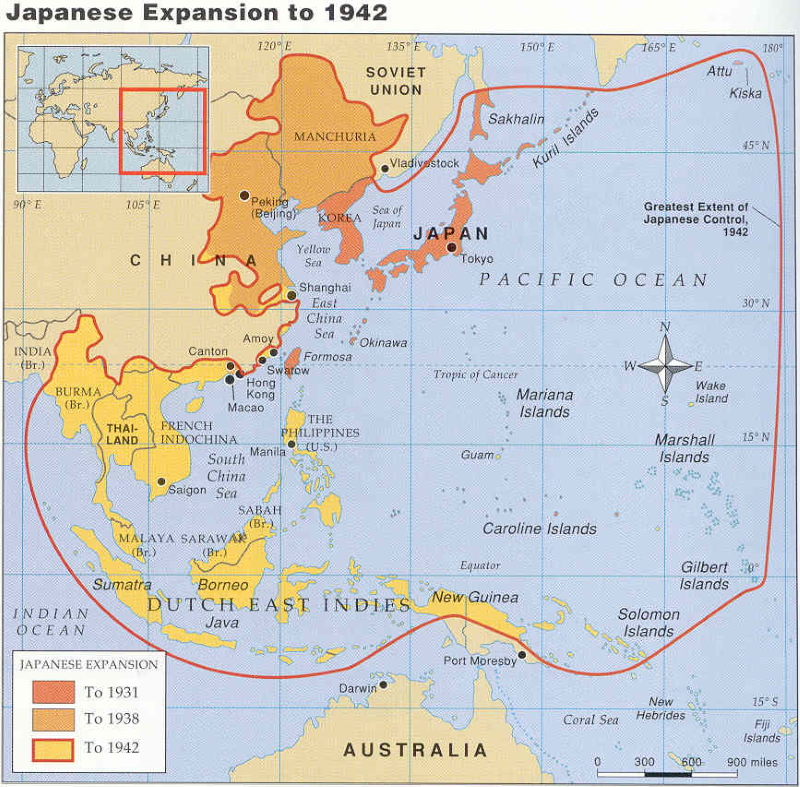 Peck and Deyle, p. 614.
Peck and Deyle, p. 614.
The British lose Singapore
(the "Gibraltar of the East") to the Japanese - February 15,
1942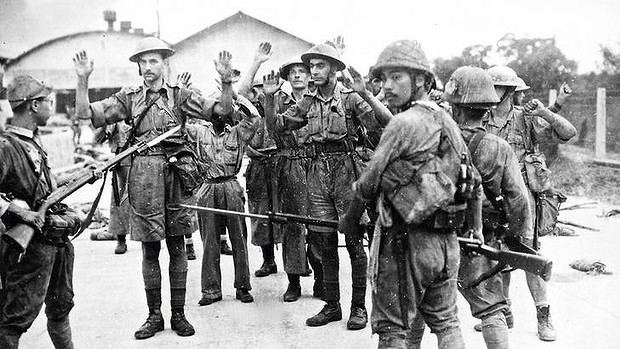
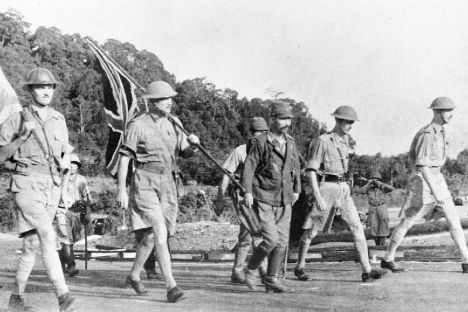 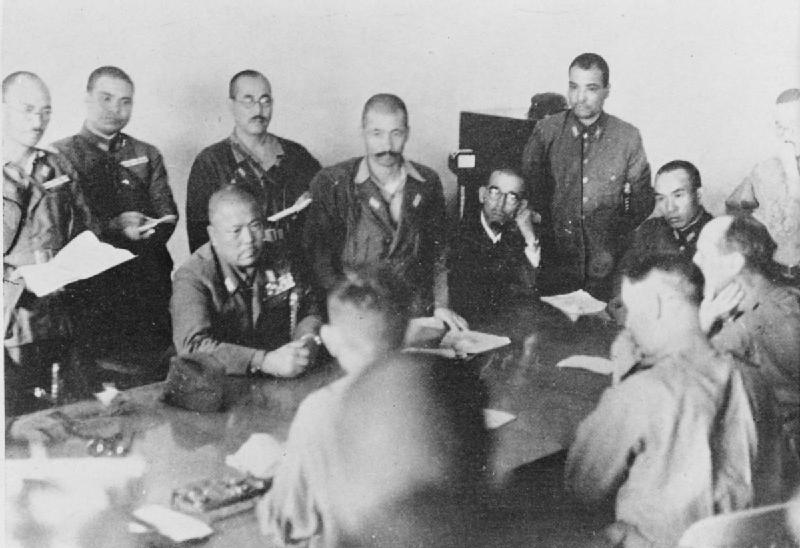 British surrender at
Singapore British surrender at
Singapore
An unprepared America is
humiliated in the Philippines
|
The fall of the
Philippines
Meanwhile, the American "protectorate" of the
Philippines came under the same Japanese assault ... though it would
take considerably more time and effort to secure the Philippines for
the Japanese Empire. The Filipinos were militarily capable
(having given America considerable resistance only some two decades
earlier) and fought with all their might against the Japanese war
machine.
But the Japanese were persistent in their
effort, and eventually the Filipinos and the 12,000 American troops
stationed there found food and weapons resupply impossible because of
the Japanese control of the Pacific at that point. Thus in early
May the last holdout at the Corregidor fortress of both the Filipinos
and Americans was forced to surrender.
The Bataan Death March
What would follow was characteristic of
the Japanese, who held in full contempt anyone who would not fight
until death … for in Japanese thinking, this was the only exit from a
bad situation. Thus American and Filipino prisoners were
force-marched 60 miles in heat without food or water to their prison in
Bataan, with thousands dying along the way – with even more dying soon after
arriving at the prison camp.1
But
again, instead of breaking the will of the Americans, folks back home,
when they heard of the Japanese atrocities, deepened their rage against
the Japanese2 ... though at the moment there was little they could do – for the country was still very
unprepared for war.
1Figures vary widely, from 2,500 to
10,000, because many of the Filipinos were able to escape along the way ...
affecting the count. Also the original
number of prisoners is not known with any precision, varying from 60,000 to
80,000 in the best estimates.
2Tragically, some
of that anti-Japanese wrath got directed toward the large number of
Japanese-Americans living in America ... most of whom were loyal
American citizens. But they would be taken from their homes and
shops nonetheless and placed in internment camps during the course of
the war. However, some young Japanese-Americans would still serve
most honorably in the American military. But overall, this
horrible treatment of its own Japanese citizens would be a most dark
mark on America’s moral profile ... not one easily wiped away even with
time.
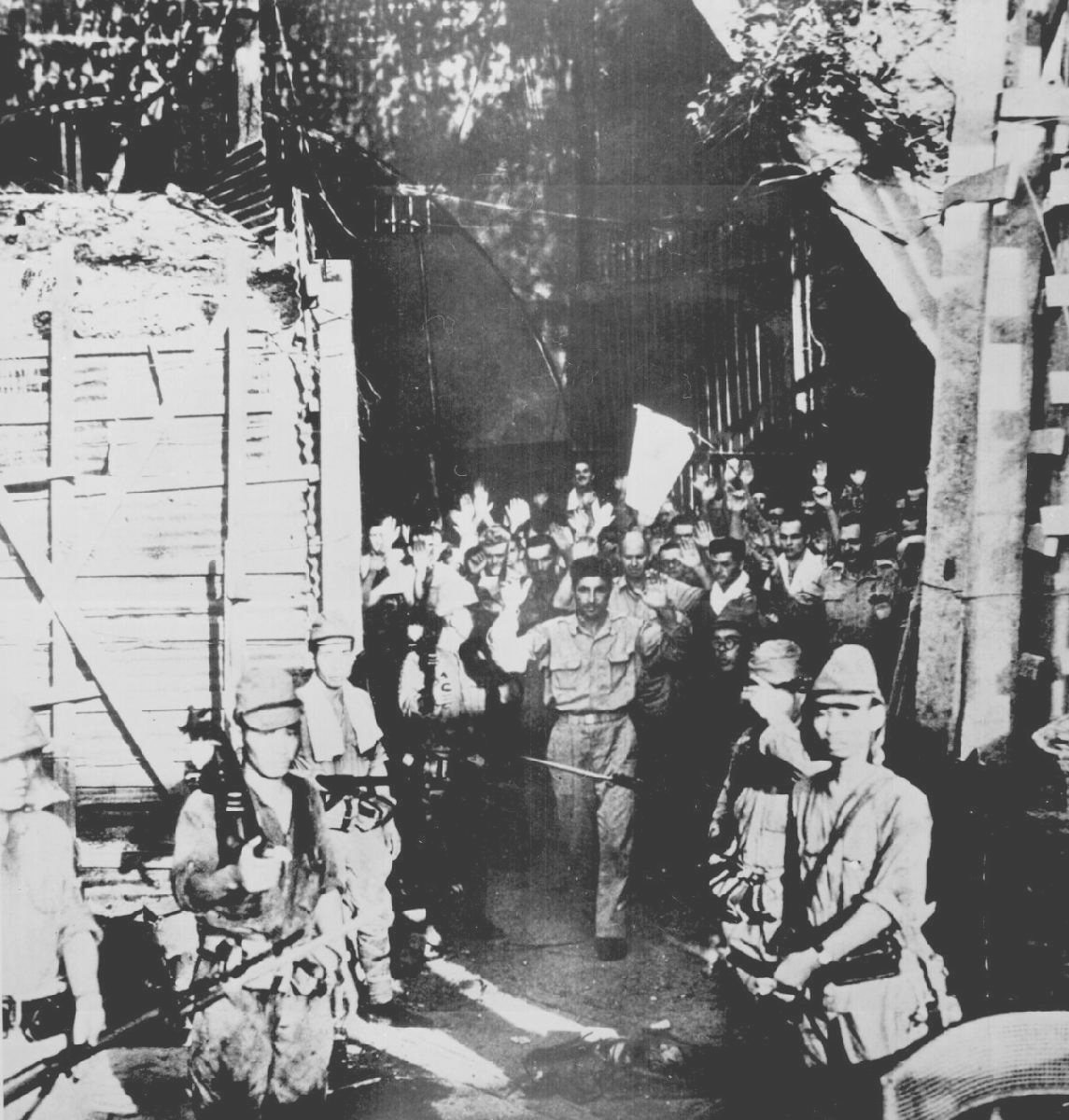 Surrender of American troops at Corregidor,
Philippine Islands, May 1942
Surrender of American troops at Corregidor,
Philippine Islands, May 1942
National Archives
208-AA-80B-1
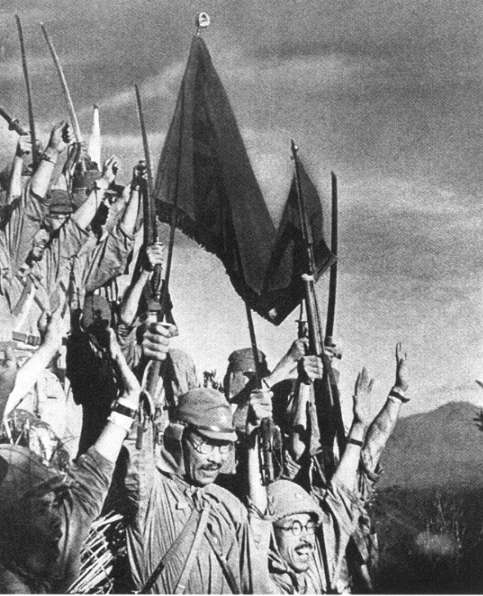 Japanese banzai
(hurrah)
for victory in a 5-month siege
Japanese banzai
(hurrah)
for victory in a 5-month siege
against the Americans and
Filipinos in the Philippines
U.S. Army
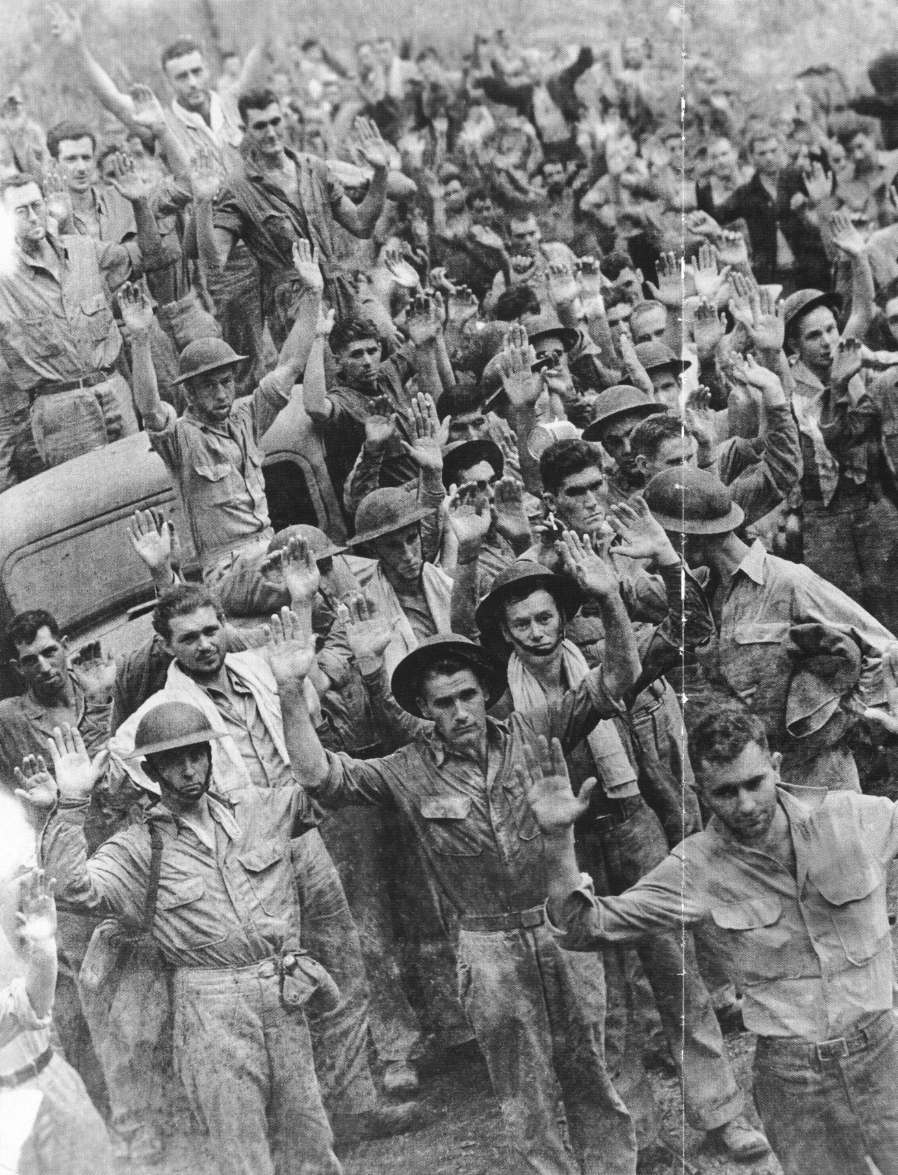
Some of the 12,000 GIs
and
64,000 Filipino soldiers who surrendered to the Japanese
at Bataan - May
1942.& nbsp; They
were
forced to take
up a 65-mile march without water and in the tropical heat to a POW
camp. Some 10,000 escaped en route – but 6,500 died along the way. Another 17,000 died in Japanese
POW camps)
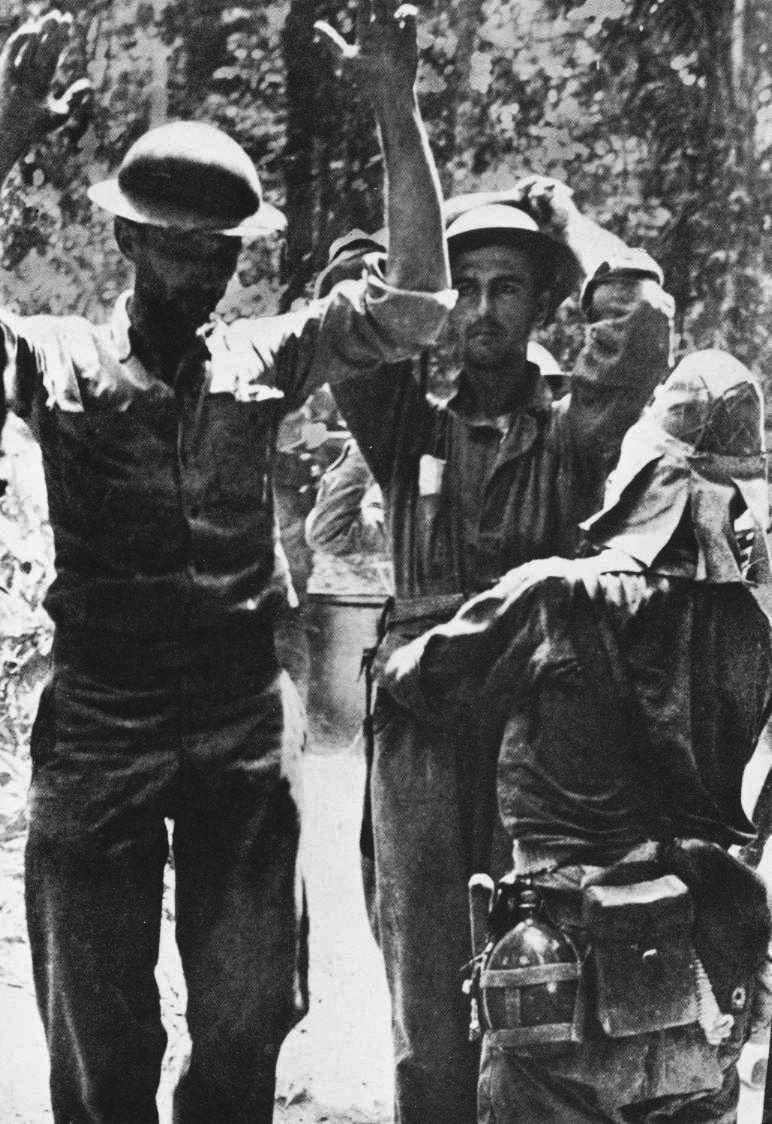
Americans
surrendering to
the Japanese at Bataan - May 1942
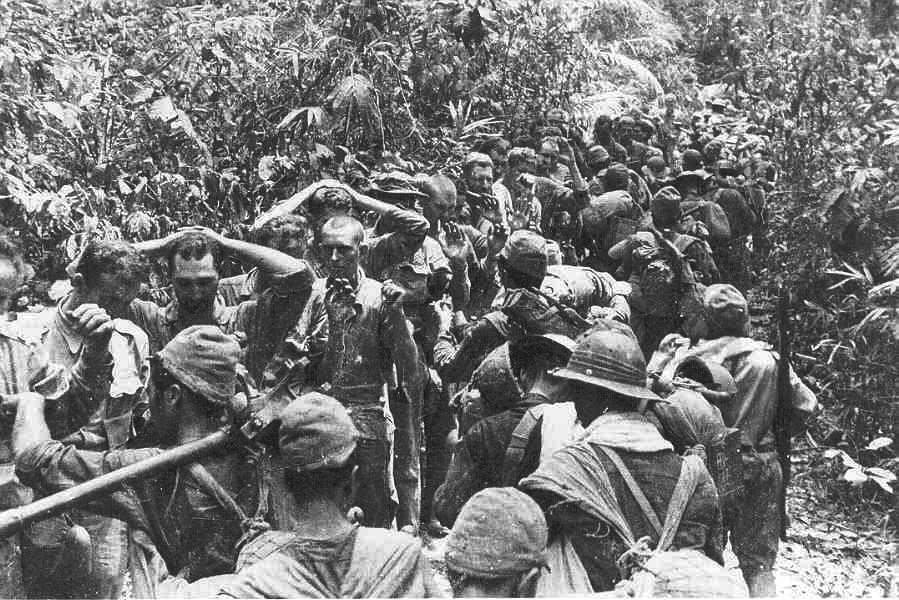 American troops
on the "Death
March" after a month-long siege on Corregidor Island - May
1942
American troops
on the "Death
March" after a month-long siege on Corregidor Island - May
1942

"The March of Death. Along the March
[on which] these prisoners were photographed, they have their hands tied behind their
backs. The March of Death was about May 1942, from Bataan to Cabanatuan, the prison
camp."
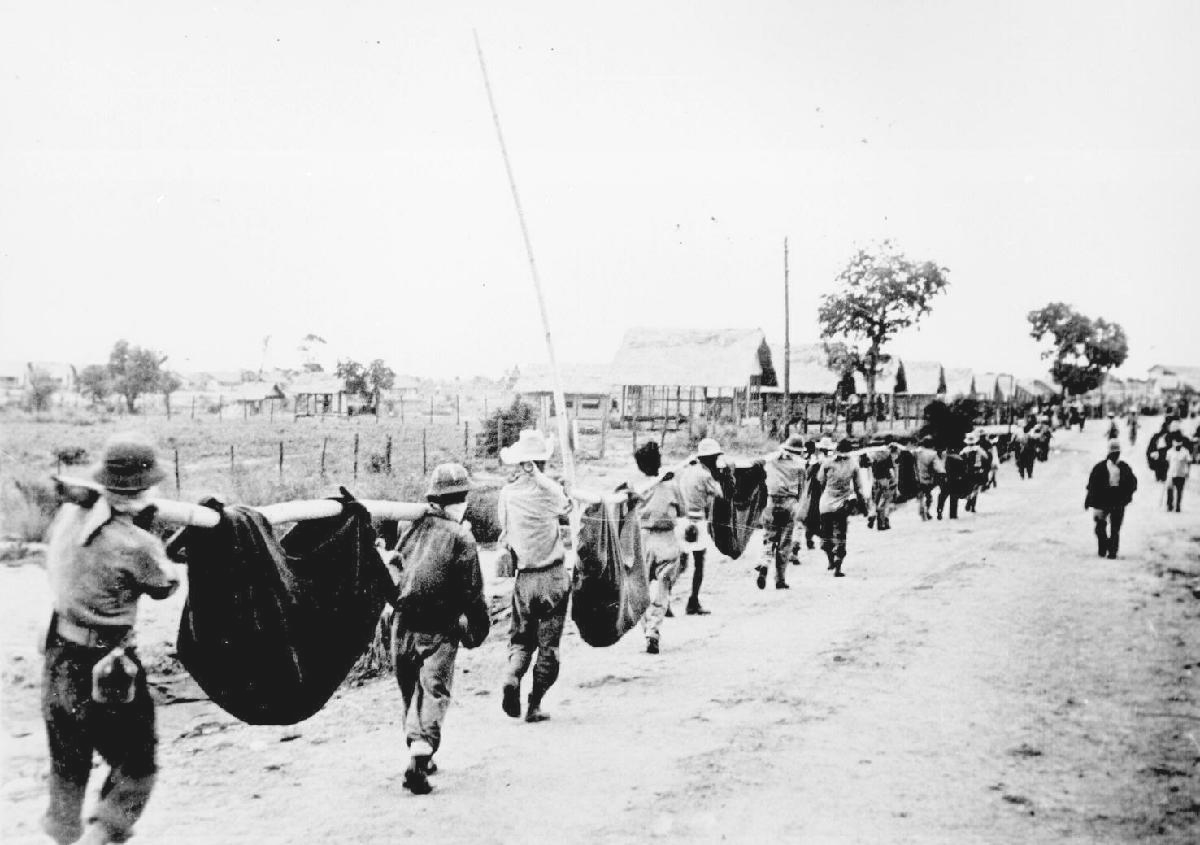
"This picture, captured from the
Japanese,
shows American prisoners
using improvised litters
to carry those
of their comrades who, from the lack of food or water on the
march from Bataan,
fell along the road."
Philippines, May
1942.
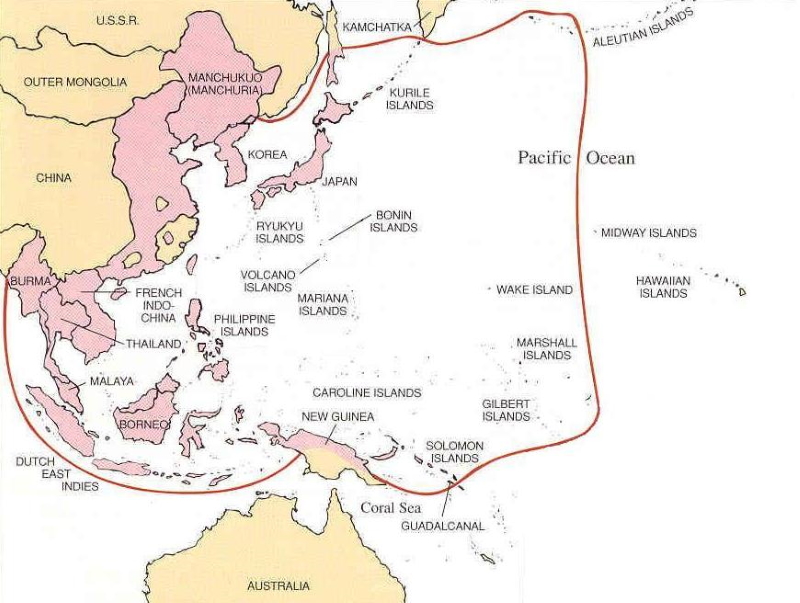 The Japanese Empire at its height –
mid-1942
The Japanese Empire at its height –
mid-1942
THE
ALLIES BEGIN THE ASSAULT ON A RETREATING JAPAN |
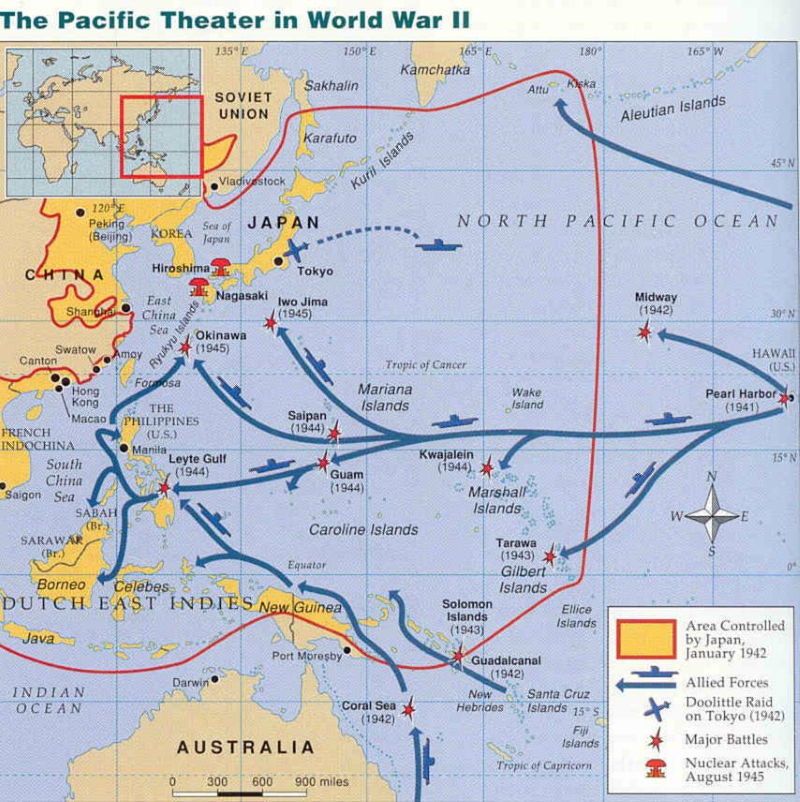 Peck and Deyle, p.
626
Peck and Deyle, p.
626
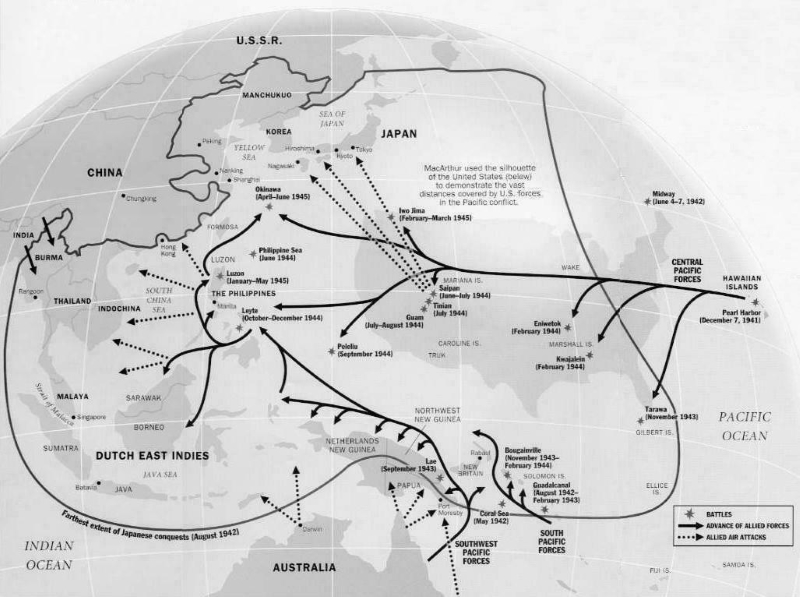
The Advance
against
Japan
Evans, pp.
322-323
THE
DOOLITTLE RAID ON JAPAN – APRIL 18, 1942 |
One
thing Americans did do, more for morale-boosting purposes than for
military purposes, was an air raid on the 18th of April on Japan
(mostly Tokyo). Down but not out, the Americans wanted to send
the Japanese a message – that Japan was vulnerable and would pay for
its ill-advised attack on America.
Sixteen B-25 bombers flew from the Aircraft
Carrier
Hornet
to bomb Tokyo and other Japanese cities - more a symbolic hit than a
serious military strike. Their bombing was not terribly
devastating – but achieved its psychological objective.
All the planes crashed (ran out of fuel) before reaching their
destinations in China - but the crews of 14 of the planes eventually
made it back to America.
They had planned to land in China in
friendly
territory after delivering their bombs. But they were forced to
start
10 hours earlier than originally planned because the fleet backing up
this mission had encountered (but subsequently sunk) a
Japanese packet boat ... but probably not before the Japanese crew
had given notice to Tokyo of the presence of this American fleet not
that far East of Japan). Awareness of this new situation forced
the Americans to make the decision to send the bombers off on their
mission immediately ... 190 miles further from Japan than
originally planned.
Nonetheless
the sixteen bombers successfully bombed Tokyo and five other cities before
heading on to China ... still 13 hours away.
They were
very low on fuel. One bomber headed for the Soviet Union and the
other fifteen were forced to crashland or bail out just inside
China, short of their designated landing sites ... and in territory
under Japanese occupation. Two crews were captured by the Japanese and
their officers executed. However local Chinese helped the other
crews get to safe territory deeper into China. And the Soviets
eventually helped the crew that landed in Russia
'escape' to Iran.
The
Japanese took revenge on the Chinese villagers who helped the
Americans. As many as 250,000 Chinese paid with their lives for
that assistance. All airfields in the region were destroyed in
order to prevent another such raid on Japan (none was planned ... as
the raid was subsequently considered almost suicidal).
Doolittle
initially thought that his raid was a total failure and expected to be
courtmartialled and stripped of command. But the raid was such a
boost to American morale that instead he received the Medal of Honor, a
larger air command ... and lasting fame!
Though Japan
suffered
relatively little material damage from the bombing, the humiliation was
so great (how could the Japanese defense force have let this happen?)
that it pushed the Japanese military to make the decision to perform a
counter-strike against the Americans at Midway Island in June ... which
turned out to be an even bigger disaster for the Japanese
military!
|
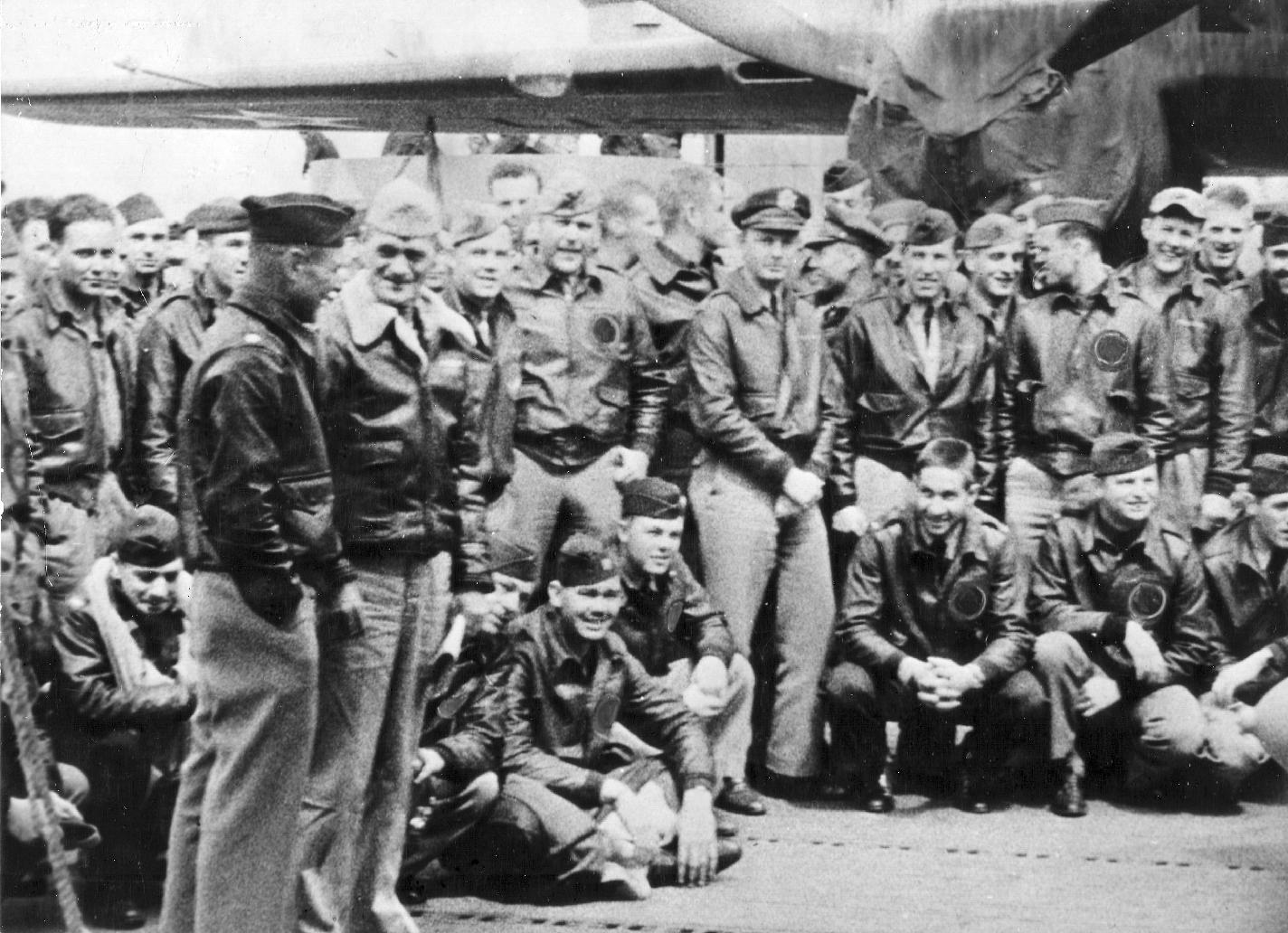
Lt. Col James Doolittle,
leader of the raid,
talks with Navy Captain Marc Mitscher,
skipper of the USS Hornet
U.S.
Navy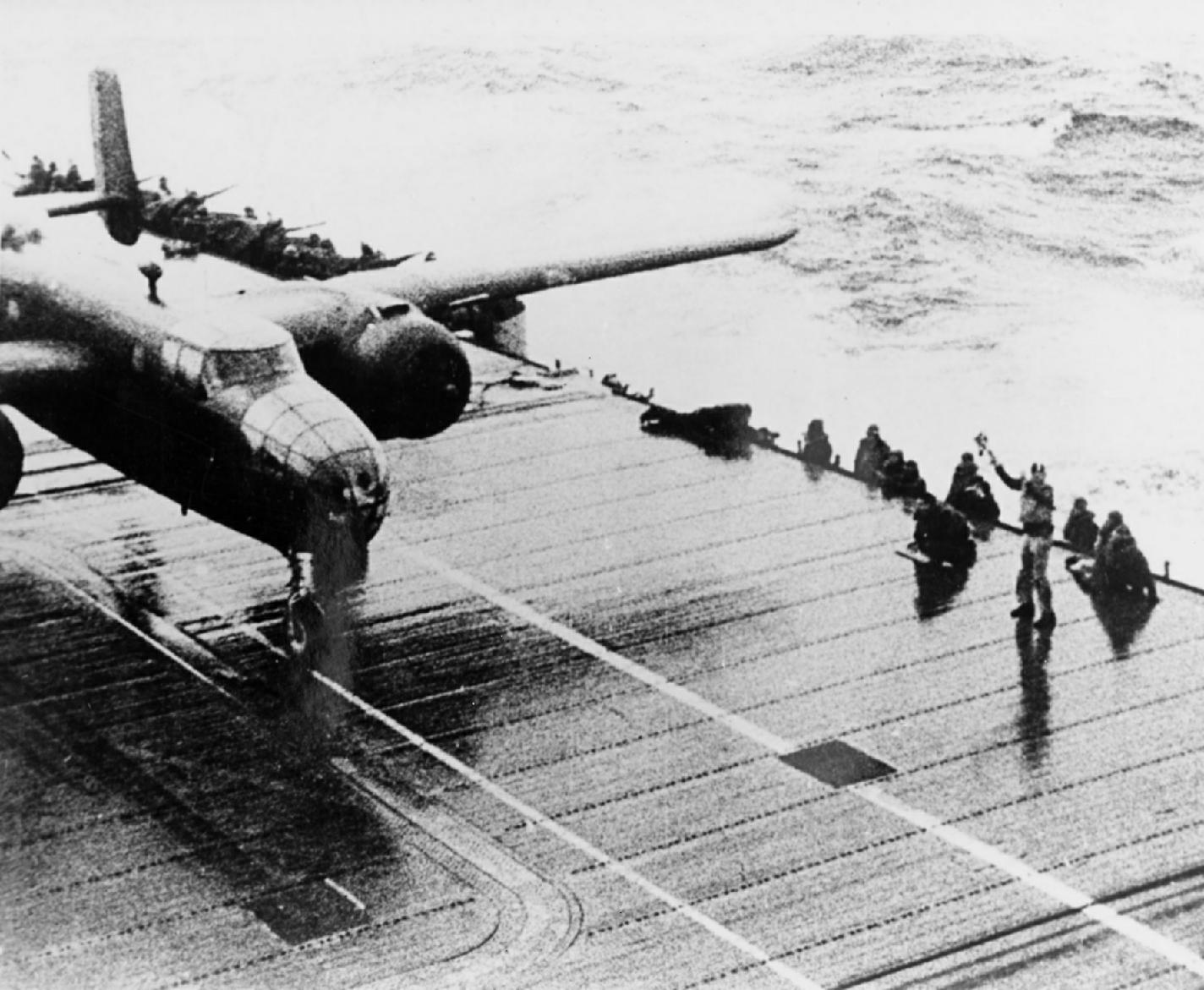
National Museum of the U.S. Air
Force
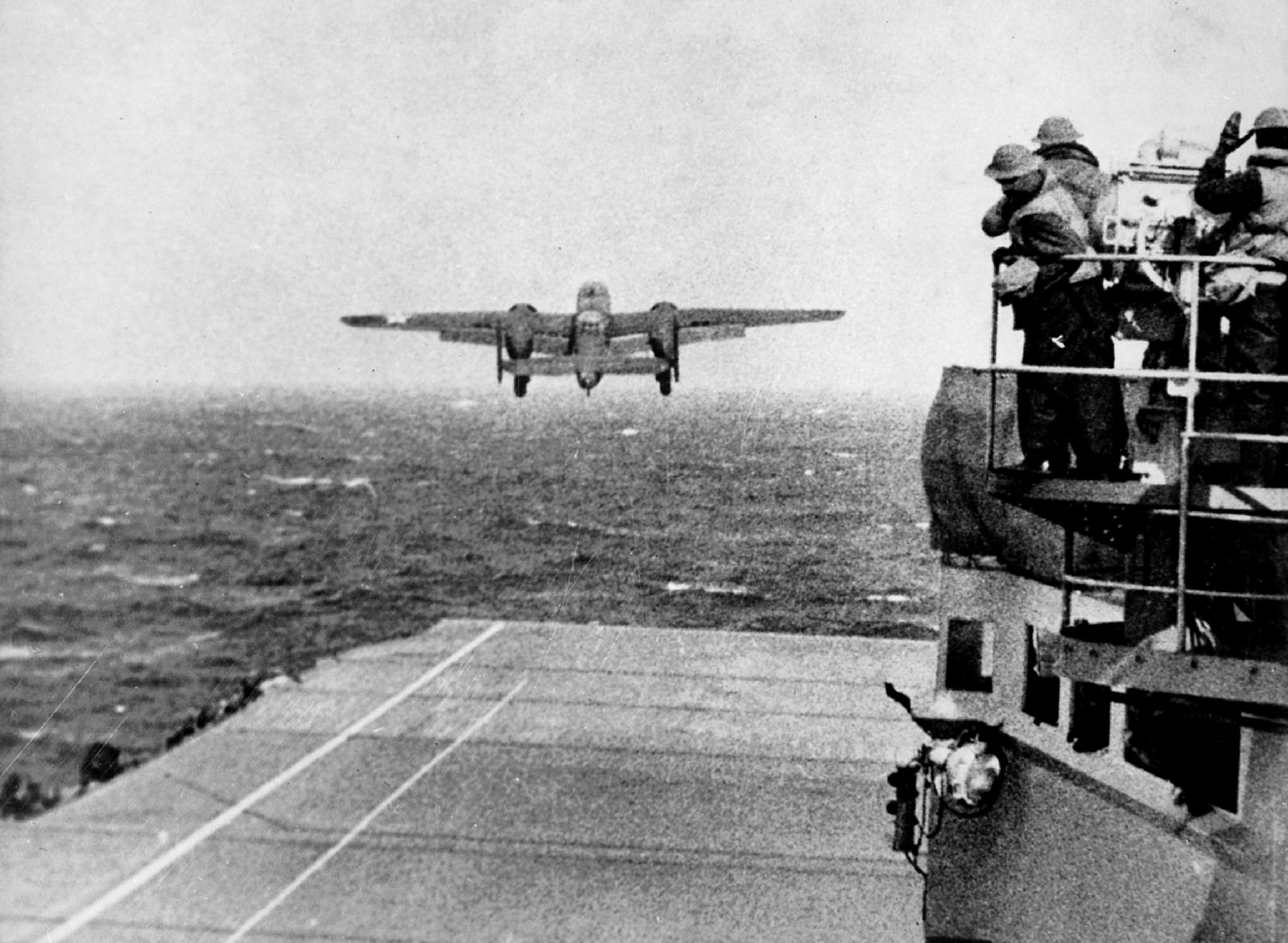
"Take off from the deck of the USS HORNET
of an Army B-25 on its way to take part in first U.S. air raid on Japan." Doolittle
Raid, April 1942.
National Archives
80-G-41196
THE
BATTLE OF THE CORAL SEA – MAY 4 - 8, 1942 |
|
In the meanwhile, during the first few months of 1942, the Japanese had
overwhelmed the greatly weakened English and Dutch, seizing all their
colonial holdings in Southeast Asia. At the same time, the French
- under Vichy governance - simply turned French Indo-China over to the
Japanese. By April the Japanese were thus ready to seize the
Australian colony in New Guinea - in anticipation of attacking and
occupying northern Australia itself – and thus sent a fleet to take
Port Moresby from the Australians. Possession of this vital port
on the southern coast of New Guinea would protect their position in the
South Pacific – and cut the supply line running from the United States
to Australia.
But
they did not know that the Americans had cracked their military code
and were aware of the general nature of this plan, guessing (correctly)
that Port Moresby was the intended Japanese target. US Admiral
Nimitz thus sent four aircraft carriers and accompanying destroyers and
cruisers to the area to intercept the unsuspecting Japanese.
The
first encounter occurred on May 4th when planes from the Yorktown
attacked Japanese in the process of landing and occupying the island of
Tulagi - sinking the Japanese destroyer Kikuzuki
and
three smaller ships, and badly damaging four others. The Japanese
were now aware of the American presence, though not its exact size or
location.
The two fleets met on May 7th, not exactly by surprise, but without
knowledge of the full extent and placement of the opposing side.
Initially both sides found themselves confused about the location
and direction of the main body of the opposing fleets. The
Japanese misidentified two American ships as carriers (actually they
were a much smaller oiler and destroyer) and sent their planes to
attack and sink them. At the same time the Americans on the
carriers Yorktown and Lexington located the Japanese carrier Shoho,
and sent their planes to attack and sink the Shoho
The
next day the two fleets were well aware of each other's location and a
full air-sea battle ensued between carriers and their planes. The
Japanese carrier Shokaku was
badly damaged, though not sunk in the fight, and had to withdraw from
action. Meanwhile the Japanese sent planes to attack the Yorktown
and Lexington - both of which became badly damaged. Then
the fighting let up. Both sides were running low on planes and
fuel.
The
Lexington had suffered serious damage to the carrier when a fire
broke out in her control station and spread quickly, igniting munitions
stored aboard the carrier. She had to be abandoned and soon sank.
Meanwhile the Yorktown returned to Pearl Harbor for repairs.
The
Japanese claimed a huge victory over the Americans - (their only
significant loss was the light carrier Shoho whereas the Americans lost
the Lexington, one of its
four major aircraft carriers). The Japanese thus led themselves
to believe that in a future confrontation with the Americans they would
destroy the rest of the American carrier fleet. Thus a battle
such as the one that subsequently developed at Midway needed to take
place soon (except that the Battle of Midway turned out to be a major
Japanese naval disaster).
But this was the first time the Japanese had failed to move their seemingly
unstoppable military machine forward - thus giving cheer to their
enemies. Indeed, this would mark the furthest extent of the
Japanese imperial reach in the Pacific - before they were forced slowly
into a devastating retreat ... and ultimately into the total loss of
the war.
|
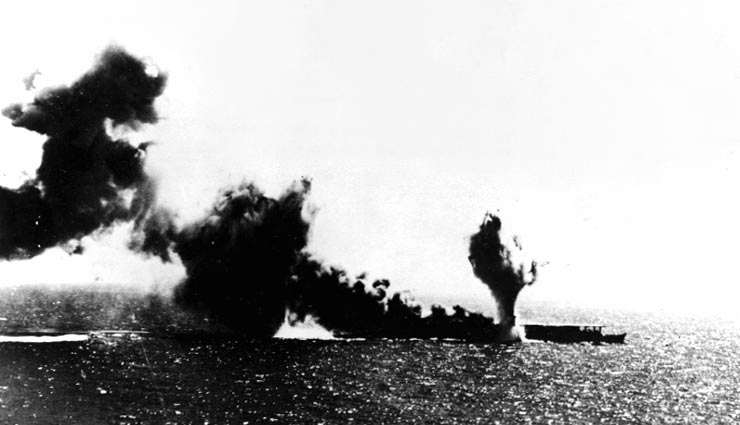 The Japanese
aircraft carrier Shoho, torpedoed
at the Battle of the Coral Sea The Japanese
aircraft carrier Shoho, torpedoed
at the Battle of the Coral Sea
U.S.
Navy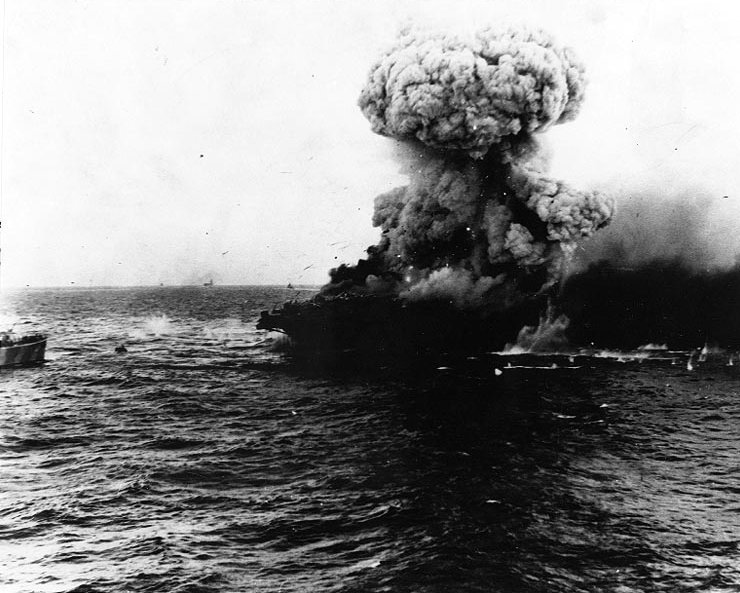
A "mushroom
cloud" rises
after a heavy explosion on board USS Lexington (CV-2), 8 May
1942. This
is probably the "great
explosion" from the detonation of torpedo warheads stowed in the starboard
side of the hangar, aft, that
followed an explosion amidships at 1727 hrs. Note USS Yorktown
(CV-5)
on the horizon in the left
center, and destroyer USS Hammann (DD-412) at the extreme
left.
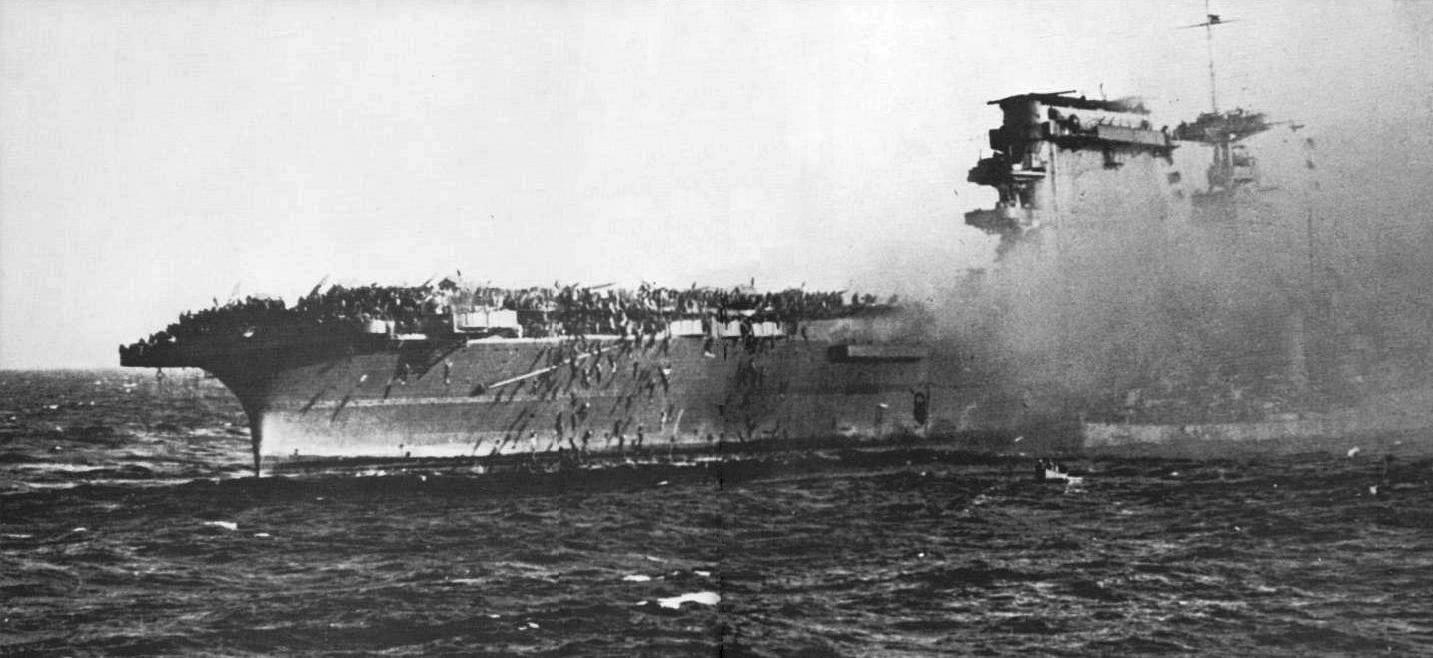
The
Lexington, burning
and sinking after the Battle of the Coral
Sea
THE
BATTLE OF MIDWAY – JUNE 4 - 7, 1942
|
|
The
Japanese attack on Pearl Harbor had clearly not achieved its objective,
bringing America to its knees – so a second hit was planned, this time
on the mid-Pacific island of Midway. The Japanese planned to
actually occupy this island – making the California coast possibly
vulnerable to Japanese air raids. The Japanese reasoned that the
seizing of Midway would finally force America to bow to Japanese power.
But
the Americans having cracked the Japanese code (somewhat) and being
aware that the Japanese were planning something big – tricked the
Japanese into revealing their goal. Thus forewarned that it was
Midway, three American aircraft carriers (though the Yorktown
was itself still badly damaged from earlier action) positioned
themselves to intercept what turned out to be 5 Japanese aircraft
carriers and a fleet of battleships and destroyers. The Japanese
were not aware that the raid was no longer a secret – and were
themselves caught off guard when planes from the American carriers
attacked their fleet.
Over the next few days (4-7 June) Americans
sank four of the Japanese aircraft carriers and a destroyer. 3
Japanese carriers were sunk in the opening rounds of the battle; 2 days later a Japanese submarine finished
off the crippled Yorktown during its effort to return to base in Hawaii. But the Japanese lost another carrier
-- and a total of 332 planes. This huge Japanese loss at Midway effectively
ended their dominance in the Pacific.
This
was a clear victory for America (though, to keep morale high in Japan,
it was announced in Japan as a Japanese victory). This left Japan
at the time with only two large aircraft carriers. But it had
also cost a huge number of lives of experienced Japanese airmen.
It
was not yet however, as some would say, the turning point of the war in
the Pacific. But the Battle of Midway, plus the naval battle in
the Coral Sea, certainly left Japan vulnerable to further American
action.
|
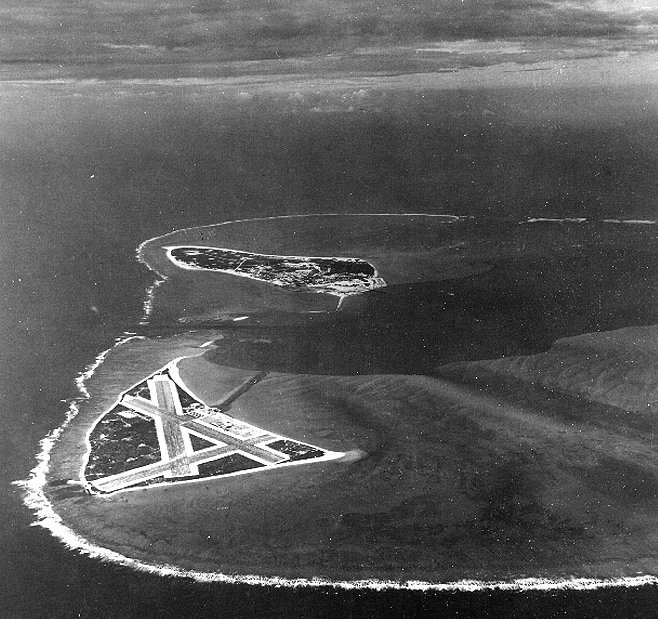
Midway
Atoll, looking just south of
west across the southern side of the atoll, November
1941.
Eastern Island, then the
site of Midway's airfield, is in the foreground. Sand Island, location of
most other base facilities, is across the entrance channel.
 Eastern Island,
Midway Islands,
under attack, 4 June 1942
Eastern Island,
Midway Islands,
under attack, 4 June 1942
U.S. Navy
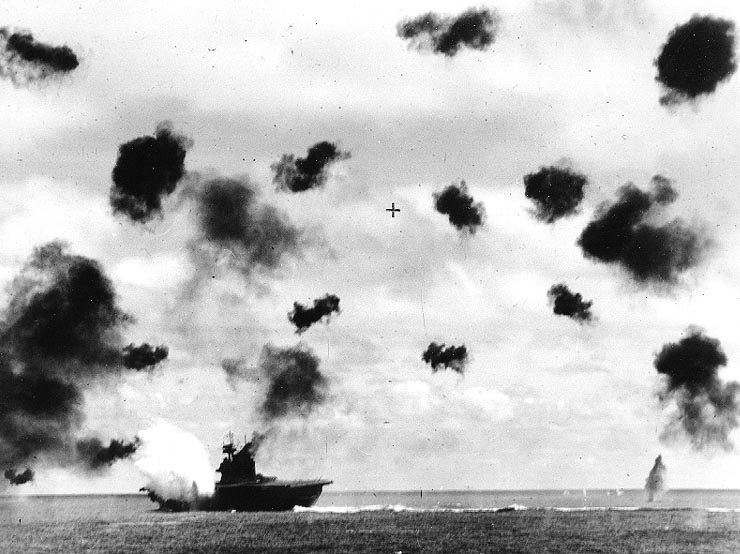
USS Yorktown is
hit by an
aerial torpedo - Midway, June 4, 1942
"USS
Yorktown (CV-5)
is hit on the port side, amidships, by a Japanese Type 91 aerial torpedo
during the mid-afternoon attack by planes from the carrier Hiryu,
in the Battle of Midway, on June 4, 1942. Photographed from USS Pensacola
(CA-24). Yorktown is heeling to port and is seen at a different
aspect than in other views taken by Pensacola, indicating that this
is the second of the two torpedo hits she received. Note very heavy anti-aircraft
fire."
Though badly damaged, she survived
this attack. But as she was making her way back for repairs, she
was sunk by a Japanese submarine on June 7. |
PD-USGOV-MILITARY-NAVY
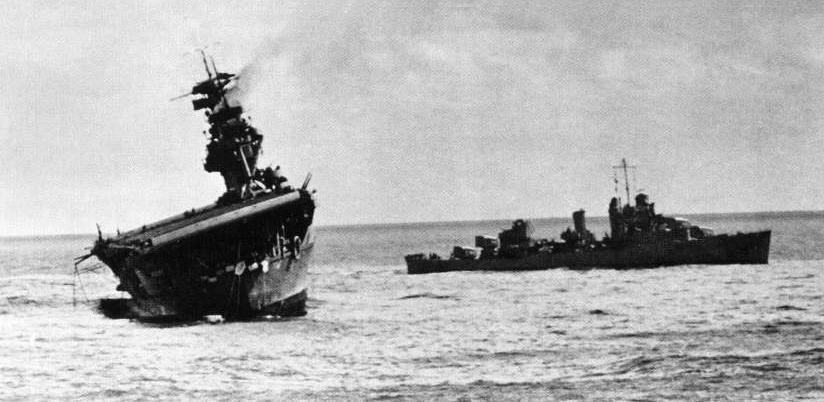
The aircraft
carrier USS
Yorktown listing heavily from a Japanese torpedo hit at Midway - June
4, 1942
U.S.
Navy
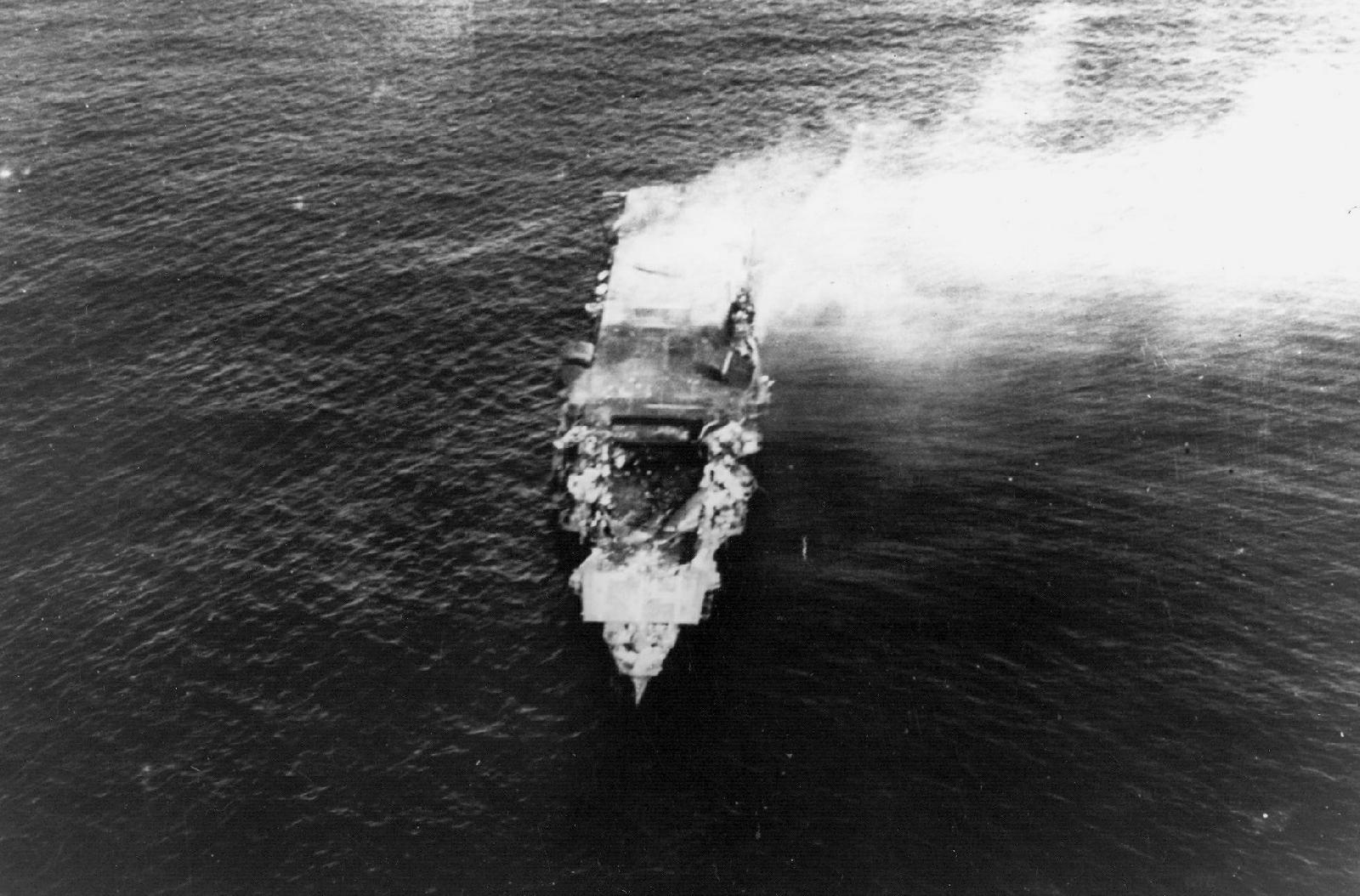
The burning
Japanese aircraft
carrier Hiryu, photographed by a plane from the carrier Hosho
shortly after sunrise on 5 June 1942. Hiryu sank a few
hours
later. Note collapsed flight deck over
the forward hangar.
U.S. Navy National Museum
of Naval Aviation
 U.S. Douglas
SBD Dauntless
dive bombers about to attack the burning cruiser Mikuma
for the
third time.
U.S. Douglas
SBD Dauntless
dive bombers about to attack the burning cruiser Mikuma
for the
third time.
| "'Dauntless' dive
bombers from USS Hornet (CV-8) approaching the burning Japanese heavy cruiser
Mikuma to make the third set of attacks on her, during the Battle of Midway.
Mikuma had been hit earlier by strikes from Hornet and USS Enterprise (CV-6),
leaving her dead in the water and fatally damaged." |
PD-USGOV-MILITARY-NAVY
 Mikuma shortly
before sinking.
- west of Midway, June 6, 1942
Mikuma shortly
before sinking.
- west of Midway, June 6, 1942
| "Japanese
heavy cruiser
Mikuma, photographed from a USS Enterprise (CV-6) SBD aircraft during the
Battle of Midway, after she had been bombed by planes from Enterprise and
USS Hornet (CV-8). Note her shattered midships structure, torpedo dangling
from the after port side tubes and wreckage atop her number four eight-inch
gun turret." |
U.S. Navy - National
Archives
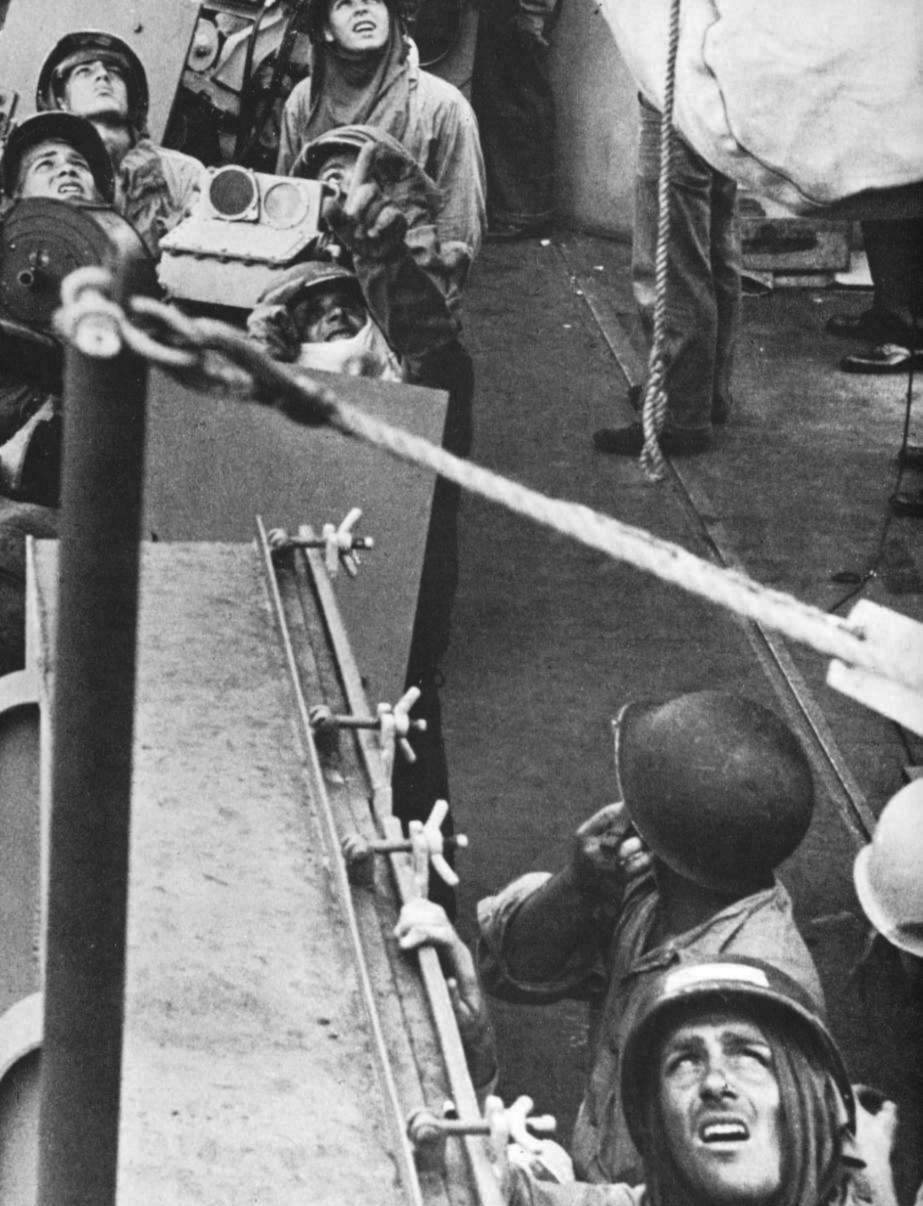
Crewmen on the
US carrier
Hornet
watching approaching Japanese planes
United States
Navy
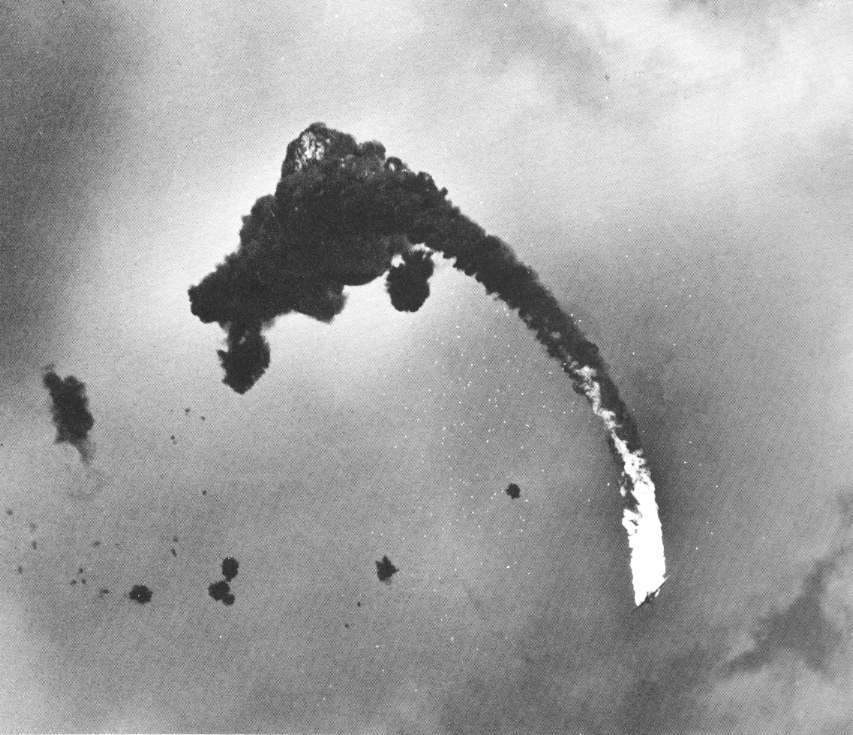
A Japanese
bomber hit by
artillery fire from the Hornet
United States
Navy
GUADALCANAL (UP FROM THE SOUTH) |
Although
Midway had been a huge event in stopping Japan’s expansion, the actual
turning point in the war in the Pacific would not occur until the
Allies’ success in the battle of Guadalcanal (August 1942 to February
1943). Guadalcanal was a huge island located among the Solomon
Islands to the north of the Coral Sea and East of New Guinea.
This long-running battle finally resulted in an Allied victory which
was very costly to the Japanese – and which indeed was the turning
point in the war against Japan.
And although the Japanese were clearly in retreat after Guadalcanal,
they fought fiercely for every inch of ground they gave up. The
Japanese soldiers clearly demonstrated at Guadalcanal that whenever
they would find themselves facing the likelihood of defeat, they would
conduct a suicidal banzai charge against American machine guns rather
than submit to the grand humiliation of surrender. Their military
code of bushido demanded nothing less.
Tragically, not only did the loss of their fellow soldiers in this
horrible war hit the Allied troops hard emotionally … seeing the
Japanese willing to be butchered by Allied hands, rather than surrender
to those same hands, unnerved the Allied soldiers greatly. It all
seemed so pointless, so evil.
|
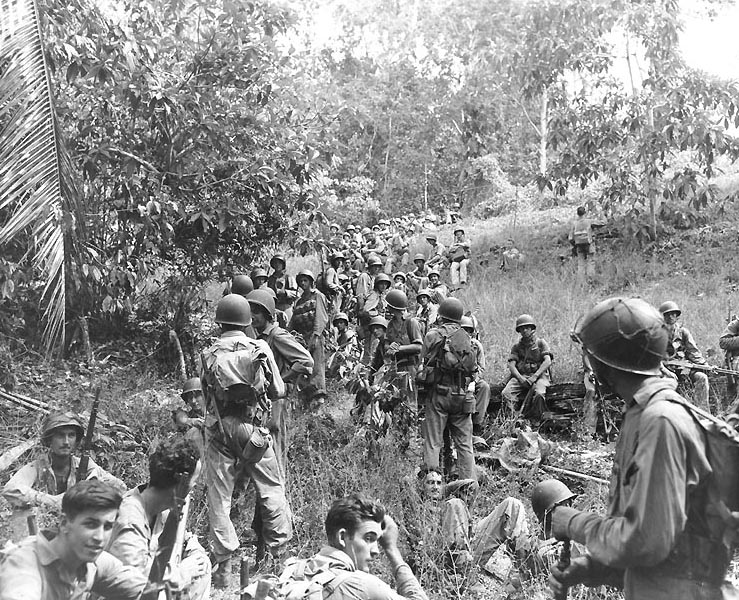 U.S. Marines rest in
the
field on Guadalcanal, circa August-December 1942
U.S. Marines rest in
the
field on Guadalcanal, circa August-December 1942
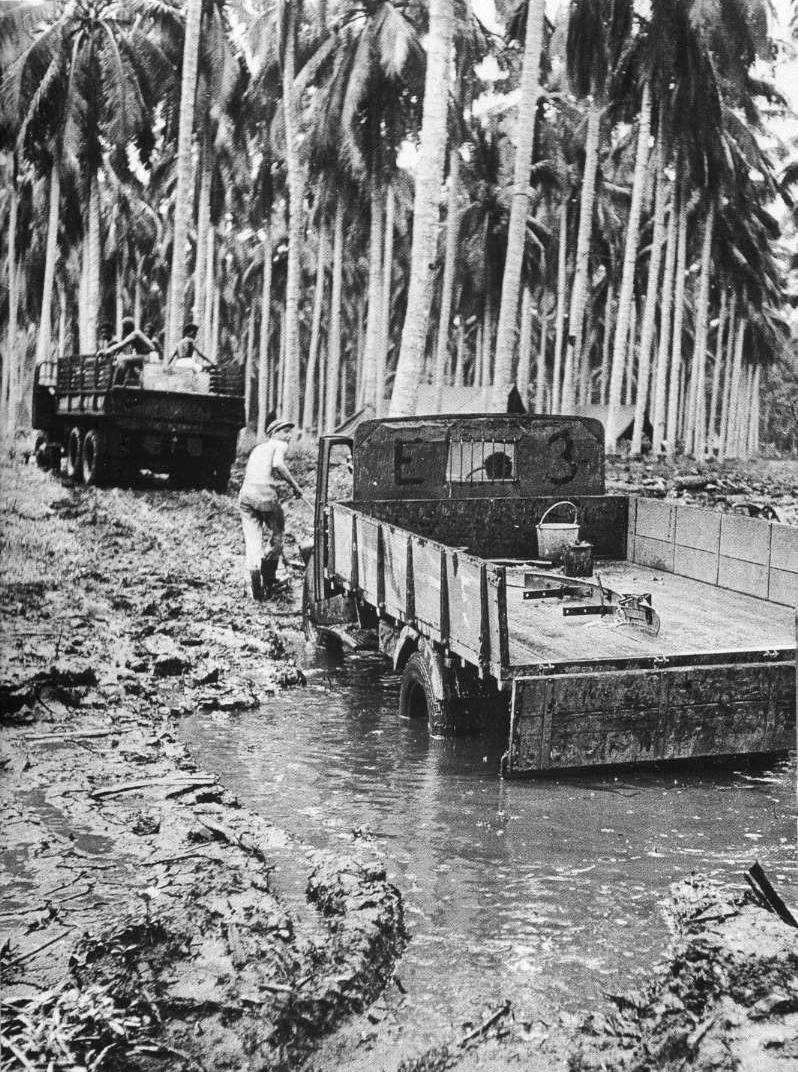
GIs slogging
their way forward
against the Japanese at Guadalcanal - 1942

GIs washing up
on
Guadalcanal
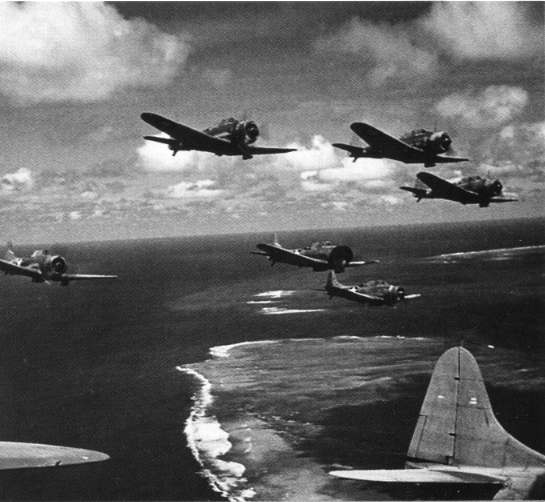 Carrier-based US
torpedo
bombers and fighters in formation for an attack
on the Japanese fleet
Carrier-based US
torpedo
bombers and fighters in formation for an attack
on the Japanese fleet
At
the very beginning of its offensive in December of 1941, Japan and its
ally Thailand had attacked British Burma (today’s Myanmar) and by April
of 1942 had forced the British out of its colony there. The
Chinese meanwhile were largely holding the line in the South against
Japanese expansion in China.
Then from their position in Burma, in March of 1944 the Japanese
attempted a new offensive against the Allies by attacking the British
position in Assam (northeast India) which the Allies had been using as
a base to fly supplies across the mountainous "hump" into China.
To counter the Japanese, India itself provided over three million
troops to the Allied cause, some of the most dedicated soldiers in the
Allied cause.
Gandhi
Most amazing was the behavior of Mohandas Gandhi who, in 1942 – when
the British were barely surviving in England under German bombardment
and when the Japanese had the British on the run in Asia – decided that
it was a perfect time to once again press for an end to British
governance in India. In August of 1942, he announced the start of
a "Quit India Movement" designed to drive the hard-pressed British from
India through a campaign of civil disobedience, something that would
make India ungovernable for the British ... and another easy Asian
target for the Japanese.
Sadly, Gandhi seemed to have no interest in looking at how the Japanese
actually treated the Chinese – or any other non-Japanese people they
had overrun. It was important to Gandhi only to get Britain to
"Quit India" … no matter what the social costs. Tragically, a
politically blinded Gandhi had no ability – or desire – to carefully
study exactly the costs versus the benefits of his campaign (typical of
all Idealists).
The campaign, however, proved to be a huge failure when the Indians
themselves showed little interest in crippling British authority in the
midst of the war, a war in which many Indians themselves were serving
in the British Imperial army.
Ultimately, the British arrested and imprisoned Gandhi – which did
inspire an Indian reaction finally – keeping him locked up until he was
released for health reasons in 1944.
Bose's Indian National Army (INA) supports the Japanese
While all of this was developing, an Indian National Army (INA) was
assembled under the leadership of pro-Fascist Subhas Chandra Bose, who
(like Gandhi) had dedicated himself to getting the British out of
India. The INA even went so far as to ally itself with the
Japanese in fighting the British (and even fellow Indian troops) in
neighboring Burma, even planning to cooperate with the Japanese in
invading India itself! Given the Japanese treatment of
non-Japanese, this was truly a highly risky – actually highly foolish –
program of the Indian Nationalists.
Nonetheless by June of 1944, the offensive proved to be a colossal
failure for the Japanese ... and the INA. This effectively ended
the Japanese ambitions in the region – and killed the momentum of the
INA.
India divides
But by this time India was beginning to divide into a number of
conflicting political, regional and religious parties:
pro-British princely states with many Indian officers in the Imperial
Army, pro-Soviet Communists, and millions of Muslims wanting to break
from Gandhi’s Hindu India ... and Punjabi Sikhs – not sure of what
would happen to them with Indian independence.
Obviously, Gandhi had given no thought as to the obvious social
conflict that would descend on India with the British departure.
But he would soon have the opportunity to witness the mass bloodshed
that accompanied his political success ... and ultimately experience
his own political reward (assassination). |
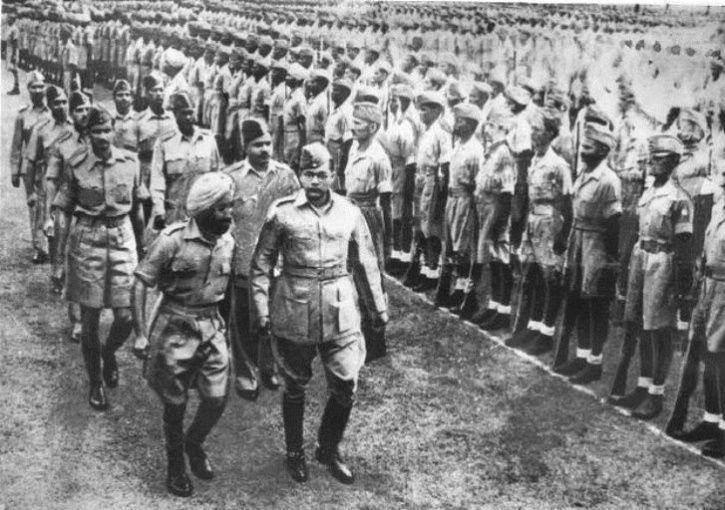 Bose inspecting his Indian National Army
Bose inspecting his Indian National Army
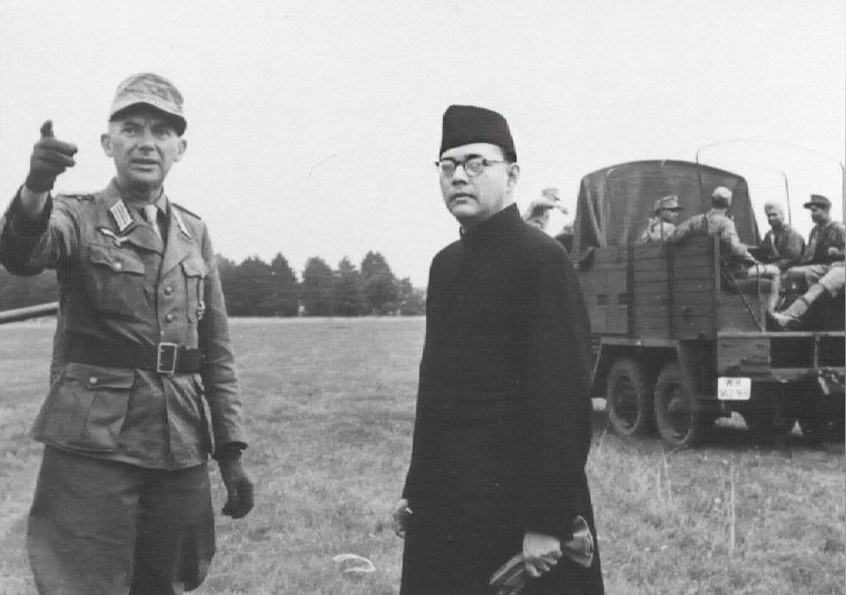 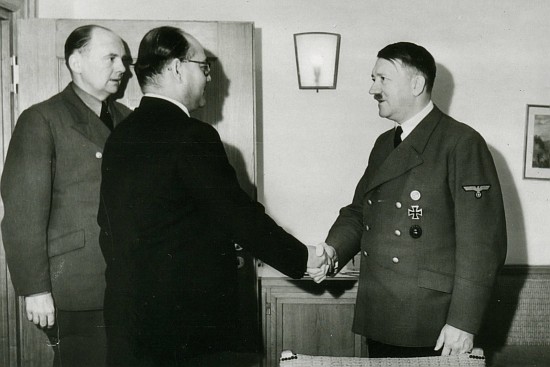 Bose with a German officer ... and with Hitler
Bose with a German officer ... and with Hitler
When Hitler seemed unresponsive to Bose's offer of alliance of his INA with Germany, Bose turned to the Japanese ... who played along with his offer
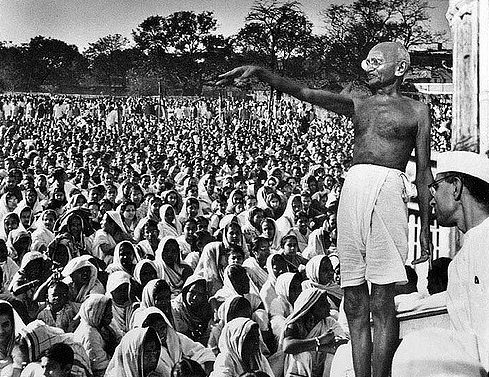 Gandhi announcing his "Quit India Movement' designed to oust the British (and their culture) from India
Gandhi announcing his "Quit India Movement' designed to oust the British (and their culture) from India
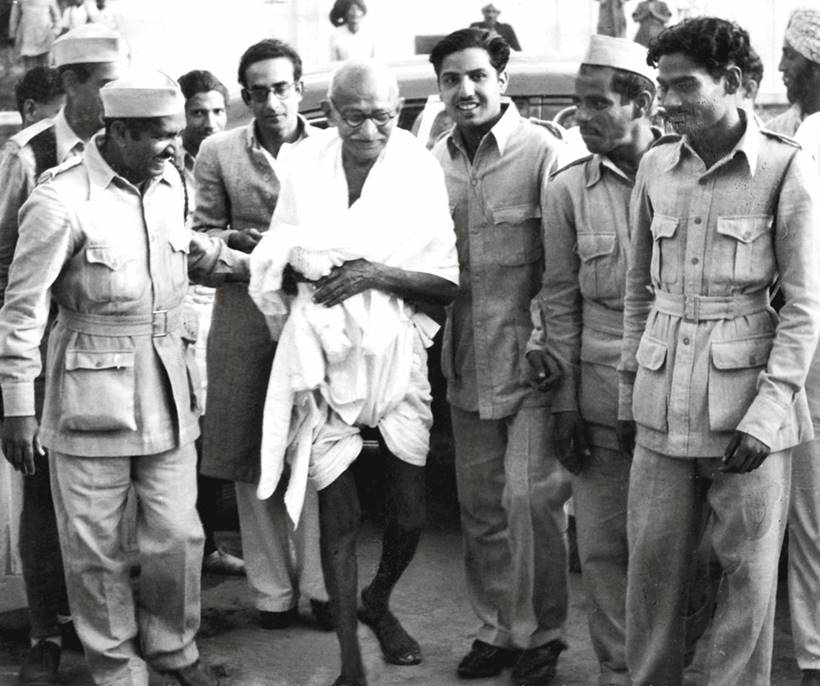 Gandhi with INA soldiers at the INA Trials - 1945
Gandhi with INA soldiers at the INA Trials - 1945
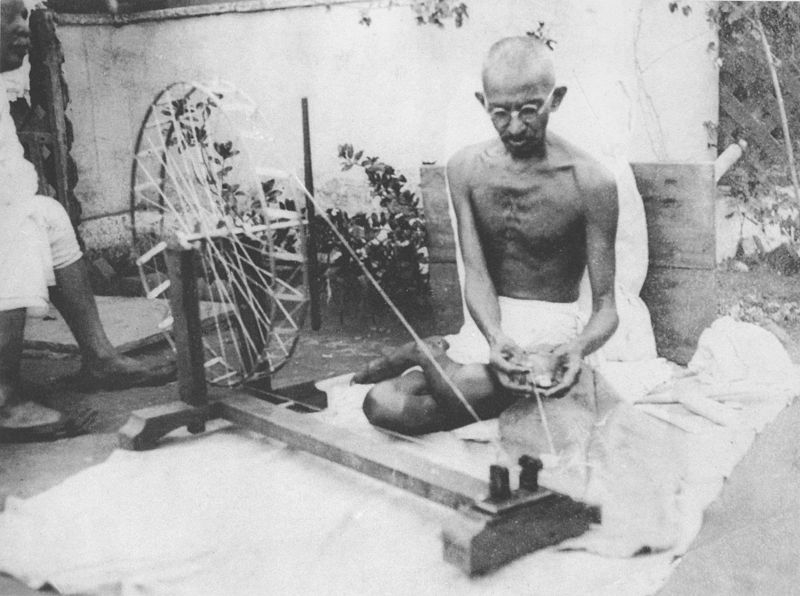
Gandhi's answer to the British-introduced industrial revolution was to go back to ancient
Indian ways (which, had India done so, would foolishly have caused the population to
starve back to its pre-British population size of about half of the current population)
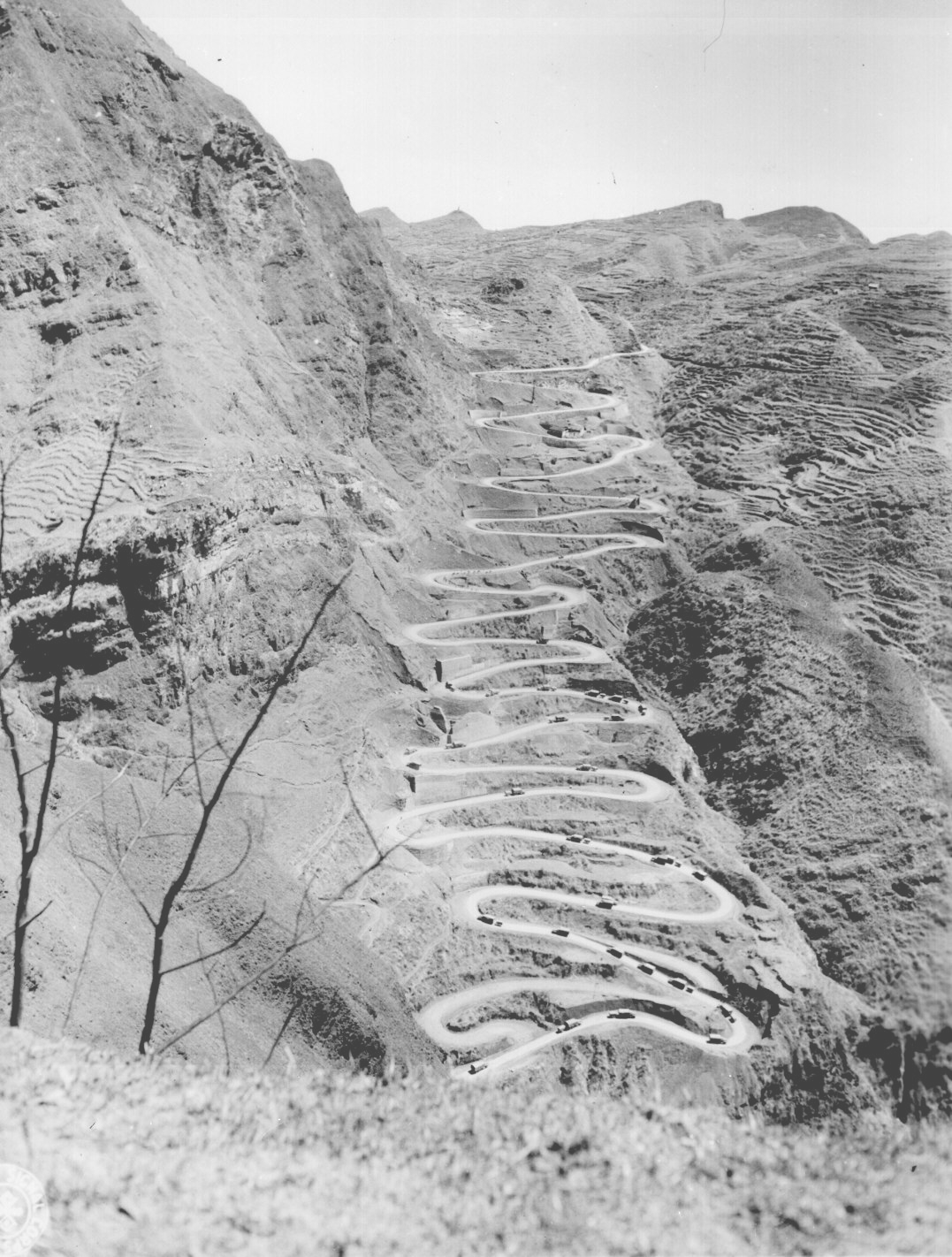 "U.S. Convoy which operates between
Chen-Yi and Kweiyang, China, is ascending the famous twenty-one curves at Annan,
China." Pfc. John F. Albert, March 26, 1945.
"U.S. Convoy which operates between
Chen-Yi and Kweiyang, China, is ascending the famous twenty-one curves at Annan,
China." Pfc. John F. Albert, March 26, 1945.
National Archives,
111-SC-208807

 Miles
H. Hodges Miles
H. Hodges
| |


 In early 1942 it appears as if Japan is
In early 1942 it appears as if Japan is The Allies begin the assault on a
The Allies begin the assault on a The Doolittle raid on Japan - April 18,
The Doolittle raid on Japan - April 18, The Battle of the Coral Sea - May 4 - 8,
The Battle of the Coral Sea - May 4 - 8, The Battle of Midway - June 4 - 7, 1942
The Battle of Midway - June 4 - 7, 1942
 Guadalcanal (up from the South)
Guadalcanal (up from the South)










































